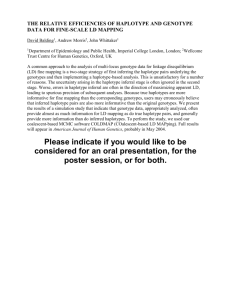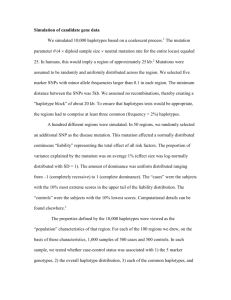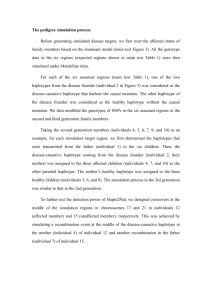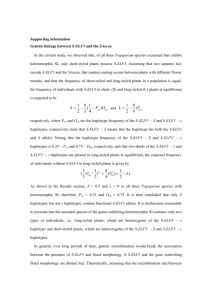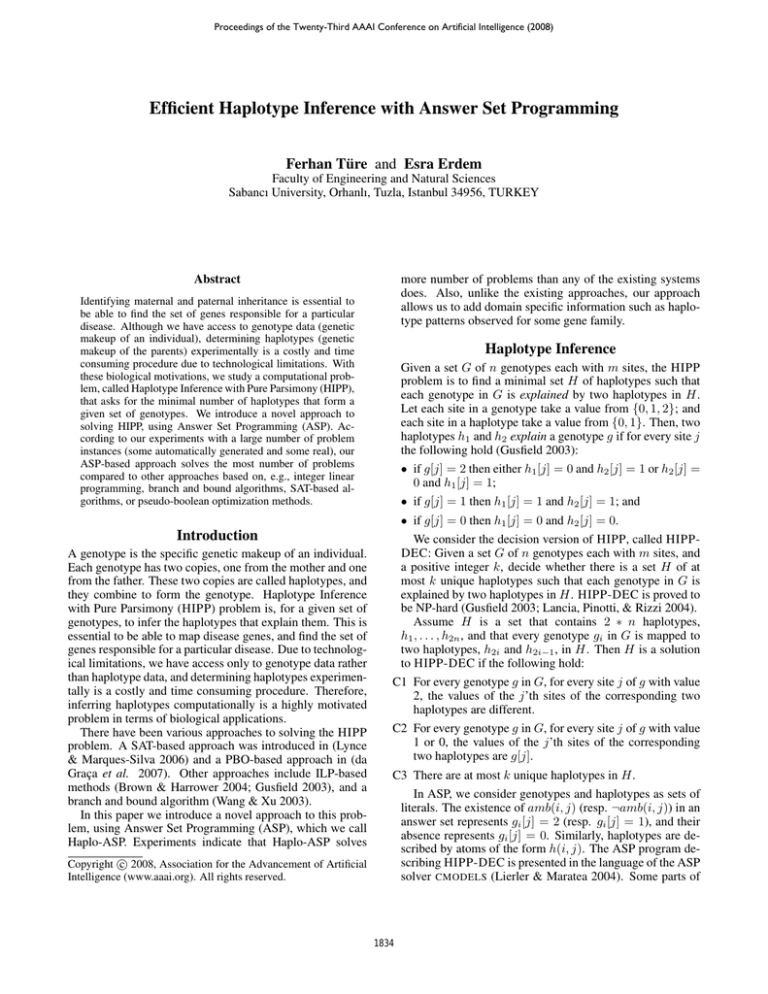
Proceedings of the Twenty-Third AAAI Conference on Artificial Intelligence (2008)
Efficient Haplotype Inference with Answer Set Programming
Ferhan Türe and Esra Erdem
Faculty of Engineering and Natural Sciences
Sabancı University, Orhanlı, Tuzla, Istanbul 34956, TURKEY
Abstract
more number of problems than any of the existing systems
does. Also, unlike the existing approaches, our approach
allows us to add domain specific information such as haplotype patterns observed for some gene family.
Identifying maternal and paternal inheritance is essential to
be able to find the set of genes responsible for a particular
disease. Although we have access to genotype data (genetic
makeup of an individual), determining haplotypes (genetic
makeup of the parents) experimentally is a costly and time
consuming procedure due to technological limitations. With
these biological motivations, we study a computational problem, called Haplotype Inference with Pure Parsimony (HIPP),
that asks for the minimal number of haplotypes that form a
given set of genotypes. We introduce a novel approach to
solving HIPP, using Answer Set Programming (ASP). According to our experiments with a large number of problem
instances (some automatically generated and some real), our
ASP-based approach solves the most number of problems
compared to other approaches based on, e.g., integer linear
programming, branch and bound algorithms, SAT-based algorithms, or pseudo-boolean optimization methods.
Haplotype Inference
Given a set G of n genotypes each with m sites, the HIPP
problem is to find a minimal set H of haplotypes such that
each genotype in G is explained by two haplotypes in H.
Let each site in a genotype take a value from {0, 1, 2}; and
each site in a haplotype take a value from {0, 1}. Then, two
haplotypes h1 and h2 explain a genotype g if for every site j
the following hold (Gusfield 2003):
• if g[j] = 2 then either h1 [j] = 0 and h2 [j] = 1 or h2 [j] =
0 and h1 [j] = 1;
• if g[j] = 1 then h1 [j] = 1 and h2 [j] = 1; and
• if g[j] = 0 then h1 [j] = 0 and h2 [j] = 0.
Introduction
A genotype is the specific genetic makeup of an individual.
Each genotype has two copies, one from the mother and one
from the father. These two copies are called haplotypes, and
they combine to form the genotype. Haplotype Inference
with Pure Parsimony (HIPP) problem is, for a given set of
genotypes, to infer the haplotypes that explain them. This is
essential to be able to map disease genes, and find the set of
genes responsible for a particular disease. Due to technological limitations, we have access only to genotype data rather
than haplotype data, and determining haplotypes experimentally is a costly and time consuming procedure. Therefore,
inferring haplotypes computationally is a highly motivated
problem in terms of biological applications.
There have been various approaches to solving the HIPP
problem. A SAT-based approach was introduced in (Lynce
& Marques-Silva 2006) and a PBO-based approach in (da
Graça et al. 2007). Other approaches include ILP-based
methods (Brown & Harrower 2004; Gusfield 2003), and a
branch and bound algorithm (Wang & Xu 2003).
In this paper we introduce a novel approach to this problem, using Answer Set Programming (ASP), which we call
Haplo-ASP. Experiments indicate that Haplo-ASP solves
We consider the decision version of HIPP, called HIPPDEC: Given a set G of n genotypes each with m sites, and
a positive integer k, decide whether there is a set H of at
most k unique haplotypes such that each genotype in G is
explained by two haplotypes in H. HIPP-DEC is proved to
be NP-hard (Gusfield 2003; Lancia, Pinotti, & Rizzi 2004).
Assume H is a set that contains 2 ∗ n haplotypes,
h1 , . . . , h2n , and that every genotype gi in G is mapped to
two haplotypes, h2i and h2i−1 , in H. Then H is a solution
to HIPP-DEC if the following hold:
C1 For every genotype g in G, for every site j of g with value
2, the values of the j’th sites of the corresponding two
haplotypes are different.
C2 For every genotype g in G, for every site j of g with value
1 or 0, the values of the j’th sites of the corresponding
two haplotypes are g[j].
C3 There are at most k unique haplotypes in H.
In ASP, we consider genotypes and haplotypes as sets of
literals. The existence of amb(i, j) (resp. ¬amb(i, j)) in an
answer set represents gi [j] = 2 (resp. gi [j] = 1), and their
absence represents gi [j] = 0. Similarly, haplotypes are described by atoms of the form h(i, j). The ASP program describing HIPP-DEC is presented in the language of the ASP
solver CMODELS (Lierler & Maratea 2004). Some parts of
c 2008, Association for the Advancement of Artificial
Copyright Intelligence (www.aaai.org). All rights reserved.
1834
% Generate a value for each site of haplotype H
{h(H,J)} :- haplo(H).
% Test the generated haplotypes wrt C1--C3
% C1
:- amb(G,J), h(2*G,J), h(2*G-1,J).
:- amb(G,J), not h(2*G-1,J), not h(2*G,J).
% C2
:- not h(2*G-1,J),-amb(G,J).
:- not h(2*G,J),-amb(G,J).
:- h(2*G-1,J), not -amb(G,J), not amb(G,J).
:- h(2*G,J), not -amb(G,J), not amb(G,J).
Conclusion and Future Work
In this paper we presented Haplo-ASP, an ASP-based HIPP
solver that describes the HIPP problem in a formal representation and uses an underlying engine to find a solution to the
problem. Unlike the existing approaches, Haplo-ASP allows
us to add domain specific information. Haplo-ASP solves
more problems compared to the state-of-the-art solvers, and
uses less computation time in large problem instances. However, Rpoly is faster than Haplo-ASP on many problem instances, so several improvements could be done to increase
performance. Some improvements to Haplo-ASP would be
to add more symmetry-breaking constraints, and to decrease
program size by some preprocessing step, as implemented
in the existing systems; this is a part of our ongoing work.
% C3
:- k+1 {unique(H):haplo(H)}.
Figure 1: Description of HIPP in LPARSE .
the ASP program is shown in Fig. 1; here G is a genotype,
J is a site, and unique describes unique haplotypes. The
program is available at (Haplo-ASP 2008).
We can easily add to the ASP program some domain specific information, e.g., some haplotype patterns observed for
the gene family. For instance, we can express that all haplotypes have value 1 at site 2 by the constraint:
:- not h(H,2), haplo(H).
Acknowledgments
Pierre Flener, Serdar Kadıoğlu, and Uğur Sezerman shared
with us their experiences with the existing haplotype inference systems. Inês Lynce and Joao Marques-Silva provided
us with the executables for SHIPs. Daniel Brown, Ian Harrower, and Inês Lynce provided us with the benchmarks.
Experiments
We compared the performance of haplotype inference systems RPoly (da Graça et al. 2007), SHIPs (Lynce &
Marques-Silva 2006), and Haplo-ASP on a workstation with
1.5GHz Xeon processor and 4x512MB RAM, running Red
Hat Linux(Version 4.3). Problem instances were all obtained
from the authors of (Brown & Harrower 2004), some of
which are real biological problems and some are artificially
generated (Hudson 2002). All problem instances were simplified as described in (Lynce & Marques-Silva 2006). A
lower bound for k can be computed as explained in (Lynce &
Marques-Silva 2006). We used the lower bounds computed
by SHIPs, then performed a binary search on the values of k
to find the minimal set of unique haplotypes explaining the
given set of genotypes.
We conducted experiments as in (da Graça et al. 2007).
For each system we assigned 1000 sec.s of CPU time to
solve each problem. We then sorted all problem instances
according to CPU times, and plotted a graph of problems
and the corresponding CPU time values. The graph is available at (Haplo-ASP 2008).
References
Brown, D., and Harrower, I. 2004. A new integer programming formulation for the pure parsimony problem in
haplotype analysis. In Proc. of WABI, 254–265.
da Graça, A.; Marques-Silva, J.; Lynce, I.; and Oliveira, A.
2007. Efficient haplotype inference with pseudo-boolean
optimization. In Proc. of AB:125–139.
Gusfield, D. 2003. Haplotype inference by pure parsimony.
In Proc. of CPM, 144–155.
Haplo-ASP. 2008. http://people.sabanciuniv.
edu/esraerdem/haplo-asp.html.
Hudson, R. 2002. Generating samples under a wrightfisher
neutral model of genetic variation. Bioinf. 18:337–338.
Lancia, G.; Pinotti, M. C.; and Rizzi, R. 2004. Haplotyping populations by pure parsimony: Complexity of exact and approximation algorithms. INFORMS Journal on
Computing 16(4):348–359.
Lierler, Y., and Maratea, M. 2004. Cmodels-2: SAT-based
answer set solver enhanced to non-tight programs. In Proc.
of LPNMR-7, 346–350.
Lynce, I., and Marques-Silva, J. 2006. Efficient haplotype inference with boolean satisfiability. In Proc. of AAAI,
239–250.
Wang, L., and Xu, Y. 2003. Haplotype inference by maximum parsimony. Bioinformatics 19:1773–1780.
Table 1: Experimental results
Category
Real
Artificial
Total
# of problems
294
40
334
SHIPs
282
40
322
of problems solved is by Haplo-ASP. Rpoly aborts for only
one problem that Haplo-ASP solves, but in most of the problems for which it has a solution, it is faster than Haplo-ASP
by a magnitude of up to 300. SHIPs aborts on 12 problems out of 334, but can solve a problem that neither HaploASP nor Rpoly can solve in 1000 sec.s. We also tried Hapar
(Wang & Xu 2003), and obtained results similar to (Lynce
& Marques-Silva 2006). For instance, Hapar can only solve
12 out of 90 for a specific set of problems (ibd).
Haplo-ASP
292
40
332
Rpoly
291
40
331
Table 1 shows the results comparing all haplotype inference systems for 334 instances (40 automatically generated,
294 real). The best performance in terms of total number
1835

